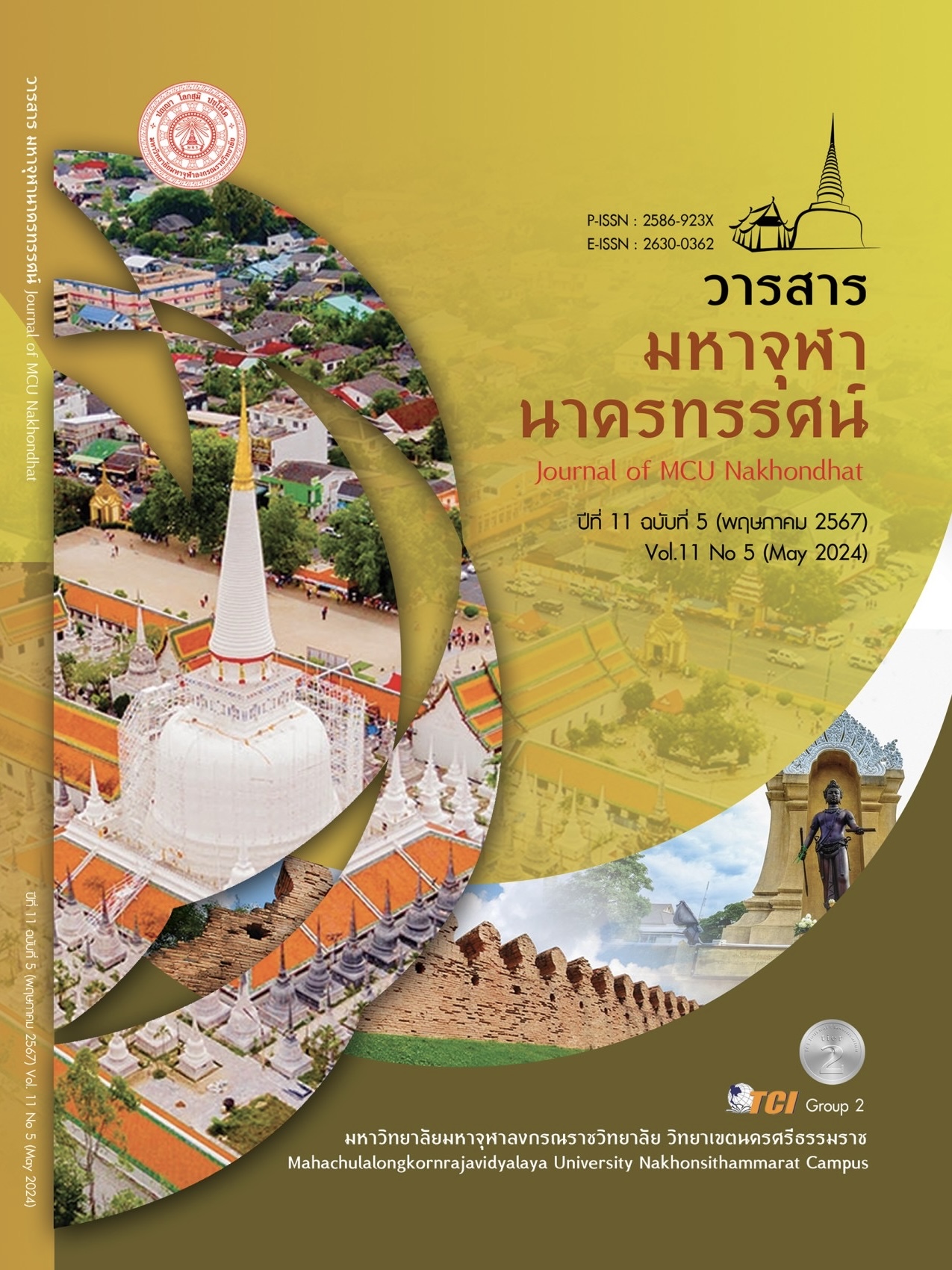DEVELOPING DIGITAL AUDIO DESCRIPTION TO HEALTH KNOWLEDGE PROMOTION ON OVER-THE-TOP TELEVISION USING IMAGINEERING PROCESS
Main Article Content
Abstract
The purposes of this research were to 1) develop a digital audio description to health knowledge promotion on over-the-top television using imagineering process, 2) study of health knowledge after exposure to digital audio description, and 3) study of receivers' satisfaction with digital audio description. This work used a mixed methods research method. It is a quantitative study plan that collects data using questionnaires and then uses the data for analysis. Along with qualitative study, data is collected using interviews and focus groups and then analyzed. The target group of the research was selected by purposive sampling, 20 vision impaired people registered in the Udon Thani Municipality area. The research tools were 1) a digital audio description to health knowledge promotion on over-the-top television using imagineering process, 2) the test of health knowledge after exposure to digital audio description to health knowledge promotion, and 3) the questionnaires of receivers' satisfaction with digital audio description to health knowledge promotion by the consistency of each question with the research objectives is not less than 0.67. The results of the research revealed that 1) the process of develop a digital audio description to health knowledge promotion on over-the-top television using imagineering process, divided into 6 aspects: imagine step, study step, design and develop step, present step, improve step, and evaluate step, 2) the 80 percent of the receivers were able to health knowledge more than criteria standards after exposure to digital audio description was at a high level, and 3) the level of satisfaction of the receivers for a digital audio description to health knowledge promotion on over-the-top television using imagineering process was at a highest level (Mean = 4.51, S.D. = 0.64).
Article Details

This work is licensed under a Creative Commons Attribution-NonCommercial-NoDerivatives 4.0 International License.
References
กรมส่งเสริมและพัฒนาชีวิตคนพิการ. (2563). รายงานข้อมูลสถานการณ์ด้านคนพิการแบ่งตามภูมิภาคของประเทศไทย 2562-2563. เรียกใช้เมื่อ 15 กันยายน 2564 จาก https://dep.go.th/th/
กุลนารี เสือโรจน์. (2563). แนวคิดการศึกษาเสียงบรรยายภาพสำหรับสื่อโทรทัศน์. วารสารวารสารศาสตร์, 13(3), 188-228.
จงรัก สุวรรณรัตน์ และธณกร ปัญญาใสโสภณ. (2565). การวิจัยและพัฒนารูปแบบความรอบรู้ด้านสุขภาพต่อพฤติกรรมป้องกันสารเคมีกำจัดศัตรูพืชและระดับเอนไซม์โคลีนเอสเตอเรสในเลือดของเกษตรกร. วารสารการพยาบาลและการดูแลสุขภาพ, 40(1), 84-93.
นฤมล อุดบุญ และนลินี ทองประเสริฐ. (2562). ปัจจัยที่ส่งผลต่อความพึงพอใจด้านการให้บริการของสถานีวิทยุกระจายเสียงแห่งประเทศไทยจังหวัดอุบลราชธานี. วารสารบัณฑิตศึกษา มหาวิทยาลัยราชภัฏสกลนคร, 16(73), 98-107.
บัญจรัตน์ สังข์น้อย และสหภาพ พ่อค้าทอง. (2560). ความคาดหวังและความพึงพอใจของผู้บกพร่องทางการมองเห็นที่มีต่อเฟซบุ๊กในฐานะสื่อสังคมออนไลน์ในเขตกรุงเทพมหานคร. วารสารเทคโนโลยีสื่อสารมวลชน มทร.พระนคร, 2(1), 34-43.
ปรัชญนันท์ นิลสุข และปณิตา วรรณพิรุณ. (2556). การเรียนรู้แบบจินตวิศวกรรม. วารสารพัฒนาเทคนิคศึกษา, 25(86), 33-37.
พงศธร ปาลี และปณิตา วรรณพิรุณ. (2561). กระบวนการเรียนรู้แบบจินตวิศวกรรมด้วยเทคโนโลยีเสมือนจริงเสริมคู่แฝดในสภาพแวดล้อมการเรียนรู้ห้องปฏิบัติการเสมือน. วารสารวิจัยราชมงคลกรุงเทพ, 12(1), 17-29.
พรรณรัมภา ยิ่งเฮง และณัฐพล รำไพ. (2563). การพัฒนารูปแบบการเรียนรู้แบบผสมผสานผ่านเทคโนโลยีคลาวด์ตามแนวคิดจินตวิศวกรรมเพื่อส่งเสริมความคิดสร้างสรรค์เชิงนวัตกรรมของผู้เรียนระดับอุดมศึกษา. วารสารชุมชนวิจัย, 14(3), 208-221.
พรรษา โนนจุ้ย. (2564). การให้สุขศึกษา. วารสารศรีนครินทร์เวชสาร, 36(2), 246-251.
วรรณวิศา วัฒนสินธุ์ และคณะ. (2563). เทคโนโลยีเชื่อมโยงสรรพสิ่งกับการเรียนรู้แบบจินตวิศวกรรมเพื่อพัฒนานวัตกรรมสร้างสรรค์. วารสารเทคโนโลยีสื่อสารมวลชน มทร.พระนคร, 5(1), 69-78.
วิชาญ ปาวัน และคณะ. (2560). การรับรู้ข้อมูลข่าวสาร ความรู้ และพฤติกรรมการป้องกันโรคและภัยสุขภาพของประชาชนไทย ประจำปี 2559. วารสารวิจัยทางวิทยาศาสตร์สุขภาพ, 11(1), 70-79.
วุฒิกนก สมแก้ว. (2563). การนำฐานข้อมูลสมรรถนะคนพิการไปใช้ในการวางแผนเพื่อพัฒนาคุณภาพชีวิตคนพิการ ในอำเภอรัตนบุรี จังหวัดสุรินทร์. วารสารการแพทย์โรงพยาบาลศรีสะเกษ สุรินทร์ บุรีรัมย์, 35(2), 257-268.
ศิริวรรณ อนันต์โท. (2564). ปัจจุบันและอนาคตของการให้บริการโทรทัศน์ผ่านโครงข่ายอินเทอร์เน็ตในประเทศไทย. วารสารบริหารธุรกิจและสังคมศาสตร์, 4(3), 116-130.
สำนักงานคณะกรรมการกิจการกระจายเสียง กิจการโทรทัศน์และกิจการโทรคมนาคมแห่งชาติ. (2560). สภาพการแข่งขันและแนวทางการกำกับดูแลกิจการ Over-The-Top Television: OTT-TV. เรียกใช้เมื่อ 15 กันยายน 2564 จาก http://202.125.84.14/data/academic/file/600900000004.pdf
สำนักงานสถิติแห่งชาติ. (2561). สำนักงานสถิติแห่งชาติเผยผลการมีอุปกรณ์รับชมรายการโทรทัศน์ในครัวเรือน ปี 2561. เรียกใช้เมื่อ 15 กันยายน 2564 จาก http://www.nso.go.th/sites/
สิโรดม มณีแฮด และปณิตา วรรณพิรุณ. (2562). ระบบนิเวศการเรียนรู้ดิจิทัลด้วยปัญญาประดิษฐ์สำหรับการเรียนรู้อย่างชาญฉลาด. วารสารศึกษาศาสตร์ มหาวิทยาลัยนเรศวร, 21(2), 359-373.
สิโรดม มณีแฮด และพงษ์พิพัฒน์ สายทอง. (2566). รูปแบบการนำเสนอสื่อสำหรับคนพิการทางการได้ยินผ่านโทรทัศน์แบบสตรีมมิงขององค์การกระจายเสียงและแพร่ภาพสาธารณะแห่งประเทศไทย. วารสารสังคมศาสตร์และวัฒนธรรม, 7(3), 283-300.
หนึ่งหทัย ขอผลกลาง และกิตติ กันภัย. (2553). งานวิจัยด้านการสื่อสารสุขภาพ: กลไกในการพัฒนาสังคม. วารสารเทคโนโลยีสุรนารี, 4(1), 65-77.
เอื้อจิต สุขพูล และคณะ. (2563). ผลของโปรแกรมการพัฒนาความรอบรู้ด้านสุขภาพและพฤติกรรมสุขภาพสำหรับประชาชนกลุ่มวัยทำงาน. วารสารวิชาการสาธารณสุข, 29(3), 419-429.
Ashraf, Md, M., et al. (2017). A Systematic Literature Review of the Application of Information Communication Technology for Visually Impaired People. International Journal of Disability Management, 11(6), 1-18.
Fryer, L. (2016). Introduction to Audio Description: A Practical Guide. London: Routledge.
Nutbeam, D. (2008). The evolving concept of health literacy. Social Science and Medicine, 67(12), 2072-2078.
Zedanzaien, S. (2020). Evaluating the Social Media Usage Pattern Among the Hearing Impaired and Visually Impaired Students at University of Tabuk. The International Journal of Social Sciences and Humanities Invention, 7(3), 5840-5851.


